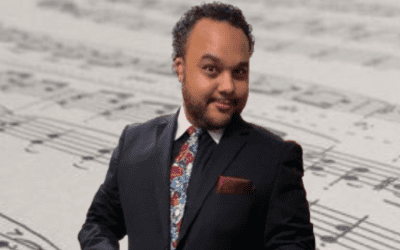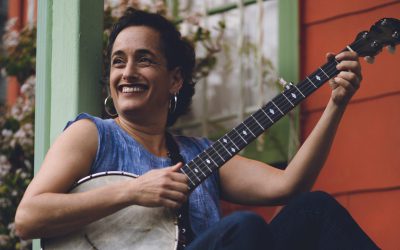An endangered species of parrot–right in San Francisco?! I talked to Frida the parrot as she was on exhibit as part of a larger an immersive art experience. This Agile Vocalist episode dives into animal sounds and share a one-of-a-kind recording of my interactions with a parrot I went to “interview.” Our interactions proved some of the most varied from any she’d had and marveled her owners, hosts and artists at San Francisco’s Gregangelo Museum.
Animal Sounds
I have always treasured that I connect so easily with animals and am delighted to focus an episode on animal sounds. As you listen and read the liner notes, I hope your empathy and understanding will grow. We need to take care of the animal kingdom; they are a lot closer to aspects of our humanity than we realize.
A Center of Gravity for Artists in San Francisco
I’d like to thank Gregangelo Herrera and Marcelo Defreitas of the Gregangelo Museum for this special opportunity with Frida the parrot. Gregangelo is also part of the career story from classically trained opera singer, Diva Marisa, in a previous episode.
Click the image below to listen on YouTube:
To listen to this episode as a podcast, search for Agile Vocalist anywhere you get your podcasts.
- The Health Benefits of Laughter
- Gregangelo Museum, San Francisco
- Animal sounds: the power of mimicry and social bonding in rainforests (really!)
- More about parrot sounds and behavior
- Animals laugh, too–say UCLA researchers
The Animal Sounds Narrators
- Narrators 1-3: David Watt, Rachel Medanic, and Chloë Medanic-Watt
- Snippets of my over an hour-long interactions with Frida, the parrot
- Laughter you’ll hear: Guest laugher, Dayna Gowan, Rachel Medanic, Chloë Medanic-Watt, Frida the parrot
You won’t always know which is Frida and which is a human so…you’ll need to listen!
Did you enjoy this? Please share it with your arts and sound-loving friends. Don’t forget to subscribe to Sound Cocktails, the Agile Vocalist newsletter.
Transcript
[3 different people, laughing- one at a time]
Narrator 1: You’ve just heard three kinds of laughter. Which one is not human?
Podcast Intro: Welcome, listen to this next Agile Vocalist podcast.
Narrator 1: What is the power of laughter to transform us? How does making the sound of laughter affect us? It feels involuntary, right? Ever find yourself curious about whether the animal kingdom has anything like it? Studies say, definitely, yes.
Narrator 2: I first heard Frida laugh as part of a show called Metamorphosis. She was a vocalist on exhibit at San Francisco’s 42-year-old Gregangelo Museum, a living and interactive destination that brings artists and audiences together for immersive experiences. With her yellow eyes and sing songy way of speaking, this rescued Yellow-naped Amazon parrot inspired me to come back a second time and try to connect with her through sound.
[Human and parrot interacting sounds] Hurry up. – Hi, hurry up. Oh, hurry up.
Narrator 3: Parrots’ ability to mimic sounds around them comes from their natural habitat, rainforests, which are noisy from all the animal and insect life within them. [Birds chirping] For creatures like Frida, laughter as an imitated sound is how she’s learned to connect with her people. She uses sound for connection. In this case, she’s learned to laugh and make sounds like a woman. [Parrot making sounds and talking as if in human speech]
Narrator 3: Parrots rely on their family groups to identify food sources or convey warnings about predators. This has evolved into an ability to replicate things like the sound of dripping water, human speech, and more. Parrots adapt to being pets by mimicking human voices and household sounds as communication with their flock. Parrots that talk in human words and sounds are exhibiting inquisitive and relaxed behavior.
Parrot: Hello!
Rachel: Hi! You want to work on our breathing? Should we work on our breathing? Frida! You have such good technique, such good technique.
Parrot: How are you?
Rachel: Such good technique. I’m so sorry, I can’t cry.
Parrot: Various speech-like sounds
Rachel: Aww, don’t cry. Oh, I know. Aww. I know. Aww. I know, it’s pretty wild. You have such great eyes. I know. It’s really, it’s really striking, isn’t it? It’s really striking, right? Yeah. Oh, look at your pretty feathers, honey. Yeah. You want to come down and see me? I’m right here.
Parrot: Um.
Rachel: You want to come down and see me? You want to come down here?
Parrot: Hello. Hi. How are you?
Rachel: I’m good. How are you? Hello. You want to come down and see me? Hi. How are you? Hi.
Parrot: Hi, Frida. Hi. Hello. Hi. Hi, Frida.
Rachel: How are you? I’m good.
Parrot: Hi. Hello. Frida, Frida. How are you?
Rachel: I’m good. Hi. Hello. Frida, Frida. How are you going? I’m good. Does it look all right? Does it look all right? Is it looking all right? Um. Is it looking all right? Does it sound all right? You think we got a good sample?
Parrot: Um.
Rachel: You’re just an amazing speaker. You’re an amazing speaker and amazing breather
Parrot: Yes. Yeah. Yes. Yeah. Yes.
I need to go to what? What? What? I want to go to. Um. Okay. Oh, should we get. Should I get free?
Rachel: Should we get takeout? Should we get takeout, Frida? Should we get takeout? You like takeout? How about Thai? You like Thai? You like Thai?
Frida: Um. No? Um. What do you think? Um. You all right? You all right with that?
Narrator 2: UCLA researchers have found 65 species of animals have vocalizations or laughter sounds that they make when they play. But in parrots, the laughter is learned imitation from watching situations where they see their humans laughing in context.
[Parrot making trilling sound]
Rachel: Oh, girl. Girl, you got a range. You got a range, Lady, you got a range. You got a big range. Can you do any? Can you do any Jim Morrison?
[Parrot laughter]
Rachel: You sound like my daughter. You sound just like Chloe. I don’t know. Frida. Hi. We got pretty excited there, didn’t we? We got pretty excited there, didn’t we? Did we get excited? Oh. Is that exciting?
Parrot: Oh, I’m in the dark.
Rachel: You’re in the dark? You’re in the dark? You’re all in the dark? Are you all in the dark? Really? Are you in the dark? Oh, honey, are you in the dark?
Parrot: What am I? Oh, my goodness, I don’t know. Where am I? I don’t know.
Rachel: Where did I put my keys? Where are you?
Parrot: Frida. Hello? Where are my keys? Where are you? I don’t know. Where are you?
Rachel: It was a marvel to hear how Frida laughed because the very tail end of it sounded close to my daughter’s laugh. Coincidence? I’ll never be sure. The first time we visited Frida, my daughter was with us
Narrator 2/Chloe, my Daughter: At the Metamorphosis tour, I did laugh. What? About four times. Around Frida. I remember distinctly that I laughed about four times around Frida.
Rachel: It takes a 13-year-old to work miracles on a script.
Through character-acted guides and introspective questions, Metamorphosis was intended to help attendees uncover their own transformational journeys. This celebration of parrots and their sound, especially Frida’s remarkably human laugh, is a tribute to Frida’s sound and the relationships between humans and parrots.
Rachel: I’m gonna go.
Parrot: Turn around.
Rachel: Oh, turn around. Okay. Oh my goodness. Oh my goodness. Oh my goodness.
Parrot: I don’t know. Well, I’ll call you back soon. I’ll call you back soon. Okay.
Podcast Outro: That was inspiring. Agile Vocalist is created and produced by Rachel Medanic. Editing by Ben Krueger. Bra






